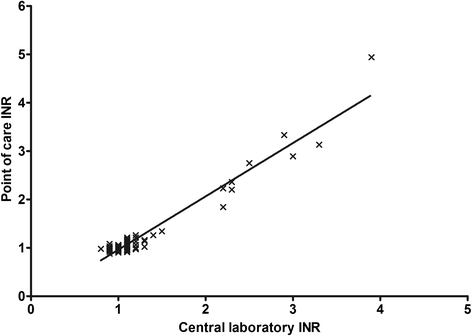Point of care coagulometry in prehospital emergency care: an observational study
- PMID: 26260487
- PMCID: PMC4542099
- DOI: 10.1186/s13049-015-0139-6
Point of care coagulometry in prehospital emergency care: an observational study
Abstract
Background: Haemostatic impairment can have a crucial impact on the outcome of emergency patients, especially in cases of concomitant antithrombotic drug treatment. In this prospective observational study we used a point of care (POC) coagulometer in a prehospital physician-based emergency medical system in order to test its validity and potential value in the treatment of emergency patients.
Methods: During a study period of 12 months, patients could be included if venous access was mandatory for further treatment. The POC device CoaguChek® was used to assess international normalized ratio (INR) after ambulance arrival at the scene. Results were compared with in-hospital central laboratory assessment of INR. The gain of time was analysed as well as the potential value of POC testing through a questionnaire completed by the responsible prehospital emergency physician.
Results: A total of 103 patients were included in this study. POC INR results were highly correlated with results of conventional assessment of INR (Bland-Altman-bias: 0.014). Using a cutoff value of INR >1.3, the device's sensitivity to detect coagulopathy was 100 % with a specificity of 98.7 %. The median gain of time was 69 min. Treating emergency physicians considered the value of prehospital POC INR testing 'high' in 9 % and 'medium' in 21 % of all patients. In patients with tracer diagnosis 'neurology', the value of prehospital INR assessment was considered 'high' or 'medium' (63 %) significantly more often than in patients with non-neurological tracer diagnoses (24 %).
Conclusions: Assessment of INR through a POC coagulometer is feasible in prehospital emergency care and provides valuable information on haemostatic parameters in patients. Questionnaire results suggest that POC INR testing may present a valuable technique in selected patients. Whether this information translates into an improved management of respective patients has to be evaluated in further studies.
Figures


Comment in
-
Point-of-care coagulometry in prehospital emergency patients--are international normalized ratios useful?Scand J Trauma Resusc Emerg Med. 2016 Feb 19;24:17. doi: 10.1186/s13049-015-0186-z. Scand J Trauma Resusc Emerg Med. 2016. PMID: 26892804 Free PMC article. No abstract available.
References
-
- Karni A, Holtzman R, Bass T, Zorman G, Carter L, Rodriguez L, Bennett-Shipman VJ, Lottenberg L. Traumatic head injury in the anticoagulated elderly patient: a lethal combination. Am Surg. 2001;67:1098–1100. - PubMed
-
- Meijer P, Kluft C, Poller L, van der Meer FJM, Keown M, Ibrahim S, van den Besselaar AMHP, Tripodi A, Jespersen J. A national field study of quality assessment of CoaguChek point-of-care testing prothrombin time monitors. Am J Clin Pathol. 2006;126:756–761. doi: 10.1309/6Q8DY5J1THA8BQG3. - DOI - PubMed
Publication types
MeSH terms
Substances
LinkOut - more resources
Full Text Sources
Other Literature Sources
Medical

